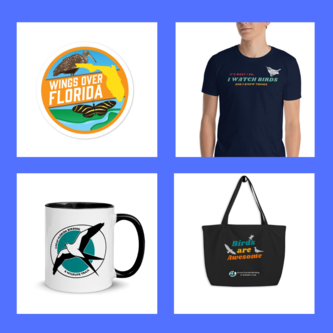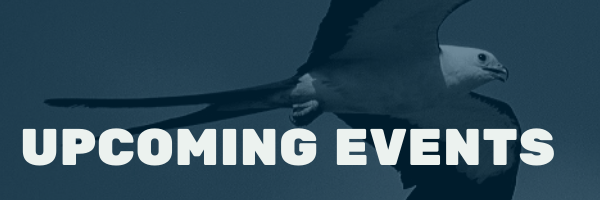
As we get closer to the holiday season, it’s a good time to start looking for gifts for your birding friends and family. We can make holiday shopping easy with our new Great Florida Birding and Wildlife Trail store!
Our new line of products includes comfortable T-shirts, sturdy mugs, roomy tote bags and colorful stickers, perfect for showing off your love of Florida birds. Wearing birding apparel is more than a fashion statement – sale proceeds will also benefit the Great Florida Birding and Wildlife Trail program as well as volunteer conservation efforts statewide.
Wearing your birding gear out in public will also help others recognize you as a wildlife watcher and conservationist. Florida communities have long made land use choices to attract traditional tourists and their dollars. Wildlife viewing is big business in Florida, but communities will only see that if we’re visible! Your visibility and economic impact can directly encourage wildlife conservation.

Picture these scenarios:
It’s late in the evening and you’ve just gotten back from a long and exhausting road trip. You just want to have something to eat and crash for the night, when your friend pops by uninvited to hang out.
You are a parent with young kids and it has been an exhausting day. You love your children but they have been particularly frustrating today – throwing tantrums, asking for snacks every half hour, not listening to a thing you say. You’re walking home with them through a local park and they’ve finally calmed down. Just then, to your frustration, one of their neighborhood friends runs by and calls out to them, and they’re suddenly all riled up again!
It’s a beautiful Florida fall evening and you’re relaxing in your back yard. Just you, a tall glass of lemonade and the latest book on birdwatching that you’ve been dying to catch up on. Suddenly, you hear a loud series of barks getting louder – your neighbor’s dog is out and off leash again! Even if you’re a dog lover, this can be a decidedly unwelcome experience.
We’ve all lived through scenarios like this where we are just trying to mind our own business and some bothersome disturbance ruins the moment.
Sometimes in the excitement of watching or photographing wildlife, it can be all too easy to do the same to the animals we love. Disturbance during periods such as migration and raising young can be particularly detrimental to birds – they’re already exhausted and getting too close can mean that they have to waste valuable energy getting away from you when they have a lot on their plates. Breeding birds can even be temporarily flushed off of nests, leaving eggs or young vulnerable to exposure and predation.
In order to minimize our effect on wildlife, remember the cardinal rule – if your presence or actions are significantly changing an animal’s behavior, you’re probably interfering too much. Luckily, there are some easy ways to minimize negative effects on wildlife:
- Stay back from concentrations of nesting or resting birds—a spotting scope may sometimes be a better choice than binoculars.
- Walk around groups of birds on the beach rather than forcing them to fly.
- Keep movements slow and steady rather than fast or sporadic.
- If viewing from your car, stay inside as much as possible. It acts as a viewing “blind” and the birds are less likely to fly if they don’t recognize you as human.
- Stay on roads, trails and paths to minimize habitat disturbance.
- Limit the use of recordings to attract birds, particularly rare or threatened species. Be aware that some locations prohibit the use of recordings.
- It is best to leave pets at home when going out for birding or wildlife viewing trips. If you do take a four-legged friend along, make sure the animal is on a leash and well controlled, and give wildlife an even wider berth. Check ahead to make sure pets are allowed at the place you would like to visit.
With these simple tips, you can make your trip much more pleasant for any wildlife you encounter. You’re also much more likely to see more wildlife – a win-win!

The impressive 1920s estate of Charles Deering sits on the Miami Rock Ridge, a unique geological feature of south Florida made up of limestone deposits from ancient coral reefs. Here visitors will find a host of interesting karst features including sink holes, razor rocks and even caves that have been carved out by water moving through the limestone. This well-protected section of the ridge hosts over eight unique Florida ecosystems. Most notably, the site has 87 acres of well-managed pine rocklands. This habitat, rich in biodiversity, was once common in south Florida but has been reduced to only 5% of its historical range.
With the diversity and uniqueness of habitats comes a plethora of species – over 200 resident and migratory birds have been recorded on-site, including rarities such as Mangrove Cuckoo and Black-whiskered Vireo. Before you go, you can explore eBird sightings or download a printable checklist to get an idea of what you are likely to see. The protected land also provides a refuge for 89 rare and endangered plant species.
Deering Estate also offers a host of classes, including virtual K-12 classes that can be done with in-person classrooms or remote learners on topics including biology, ecology, archaeology and physics. Classes and tours for adult learners on everything ranging from photography to history to conservation are offered both virtually and in person.
If you tire of wildlife viewing and hiking during your trip (which we suspect will be unlikely, given the impressive offerings at this site), you can also explore the estate itself by touring the extensive historic buildings and viewing some of the multiple art exhibits on display. The estate will even be hosting a vintage auto show on Nov. 8 – there is certainly something for everyone here!
The Deering Estate is currently open to visitors and masks are required for visitors in both the indoor and outdoor areas of the estate. For more information on guidelines and requirements related to COVID-19, visit deeringestate.org/covid-19.
Address: 16701 SW 72 Ave., Miami, 33157
Phone: 305-235-1668
Hours: 10 a.m. - 5 p.m. (no admission after 4 p.m.). Open every day except Christmas and Thanskgiving.
Admission: Adults (15+) - $15; Youth (4-14) - $7; Ages 3 & under - Free
DeeringEstate.org

October 31 – Hernando Audubon Birding Trip to Ahhochee Hill Sanctuary (Brooksville)
November 11 – Photographing Birds in St. Johns County (Virtual)
November 14 – Limited Edition Field Trip: Lake Apopka North Shore, Clay Island Trailhead (Clermont)
November 14 – Bioblitz Nature Walk (Clermont)
November 16 - Backyard Birding 101 – Urbirdin’ with Jax Zoo’s W.I.L.D. Team (Virtual)
November 17 – Bird Walk at Masters Tract (Hastings)
November 20 – Birding in Paradise (Virtual)
Check out the events page of our website for more events across the state!
Do you know about any other bird or wildlife-related events going on in Florida? Help spread the word by letting us know! Send in the times, dates, locations and contacts to WildlifeViewing@MyFWC.com for posting on the Great Florida Birding and Wildlife Trail website.
Events must be related to birds or other wildlife and must be open to the public. Examples include interpretive programming, summer camps and family programs.
|